Interview with Kate Lavender by Polly Marix Evans – Stained Glass artist – at Rheged – 19 May 2025
I’ve never met Kate before, usually I’ve at least bumped into my victims (!) before I interview them, and, rather poorly, I’d not even done my homework and looked her up online as I’ve been so busy with my own work.
We’d been emailing about where to meet and how to fit it all in around our other commitments and decided that Rheged was pretty much halfway between us both, and they serve teas and coffees, and have good things to look at like The Great Print Exhibition, or Nest, or plenty of other bits and bobs and fun stuff to lust after or buy. I’d suggested I could hold an umbrella so Kate knew who I was but, as we decided to meet indoors and it hasn’t rained for weeks, Kate thought I might look like a bit of a twit, so that was that. Kate said she’d be wearing dungarees, a T-shirt and a floral cross body bag. I was instantly in awe of someone who could plan their wardrobe so far ahead – my own clothing choices are very last minute and often slightly unusual! It’s ok, reader, I went for cargo trousers done up with a purple shoe lace and one of many strappy black tops.
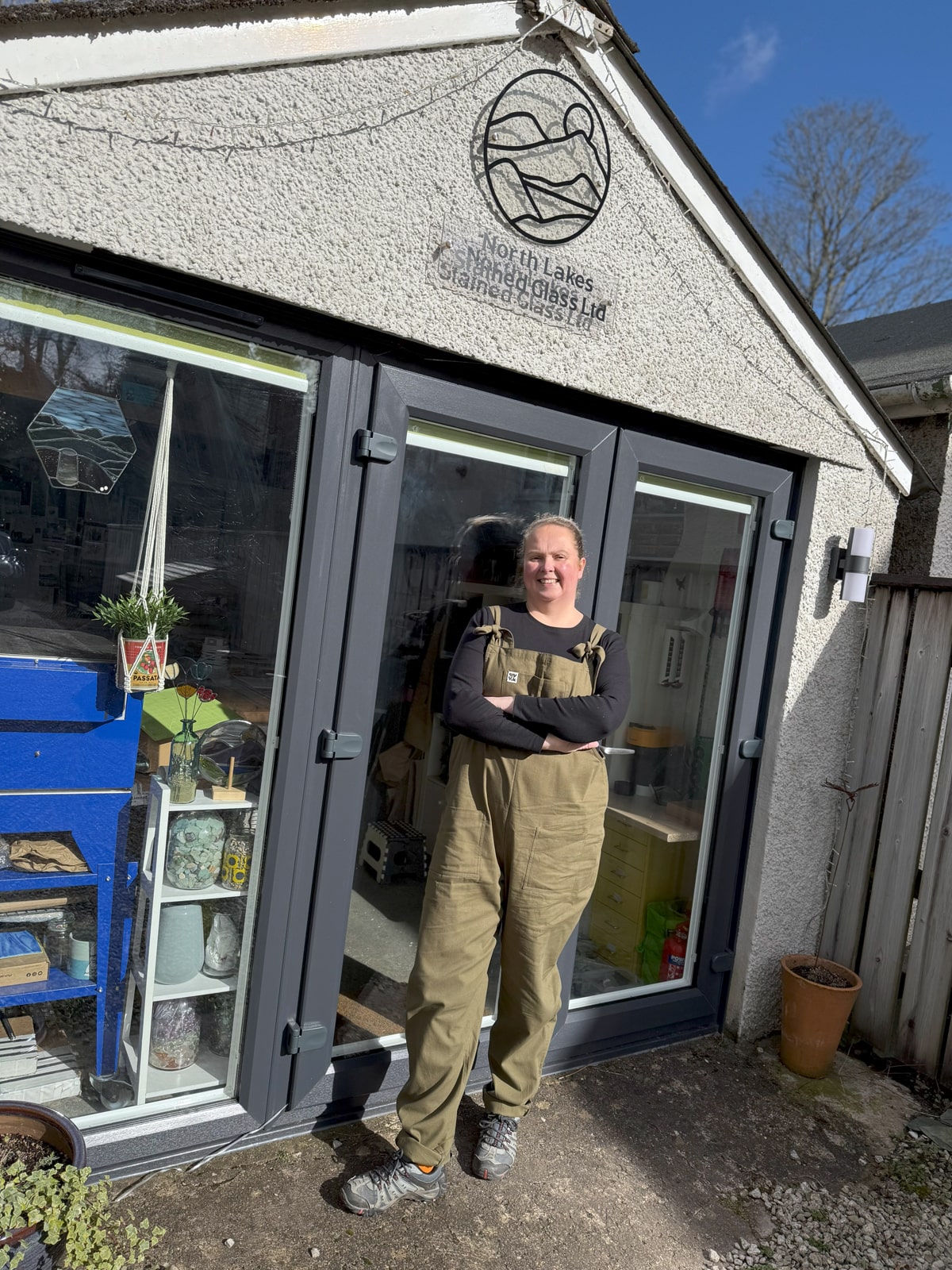
Kate is a stained glass artist based in Keswick. She works from her home studio – a converted garage which is compact, you can reach most things without moving far, and about the shortest commute to work you could possibly want. It may be small, but it’s enough space for both her larger projects and to hold her regular workshops of up to 3 students.
I ask Kate where it all started and we have a fantastically digressy three hour chat where we both go round and round lots of houses and conversational detours, so I’m going to do my best to build a slightly more straight-line write-up.
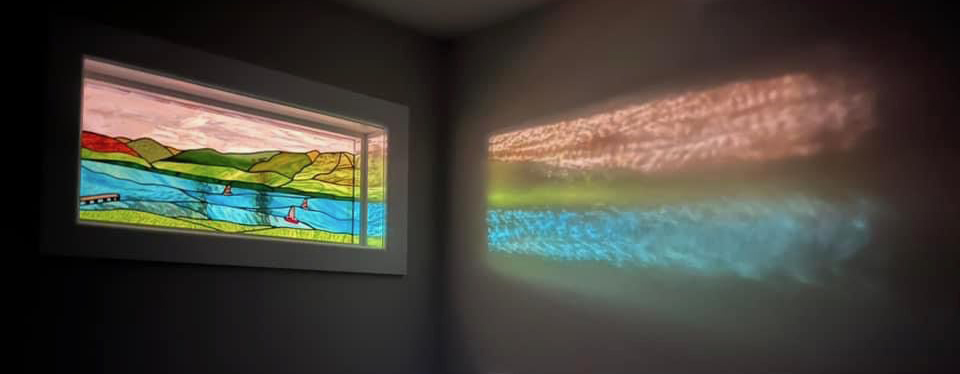
She grew up in Bristol. Both her parents were teachers. She was a sporty child. In the summer holidays she attended quite a few clubs but, ‘there’s a limit to how many sports activities a child can do without getting exhausted and moody,’ so, aged 10, she went to something called The Girls’ Workshop, her parents hoping to find something to interest her that might not totally wear her out. It was the 1990s. Schools were still not encouraging girls to do anything too non-feminine that involved power tools or dirty hands, but The Girls’ Workshop was different. Kate saw the beautiful glass, then she saw the intriguing and ‘dangerous looking’ tools for soldering and cutting and thought wow!
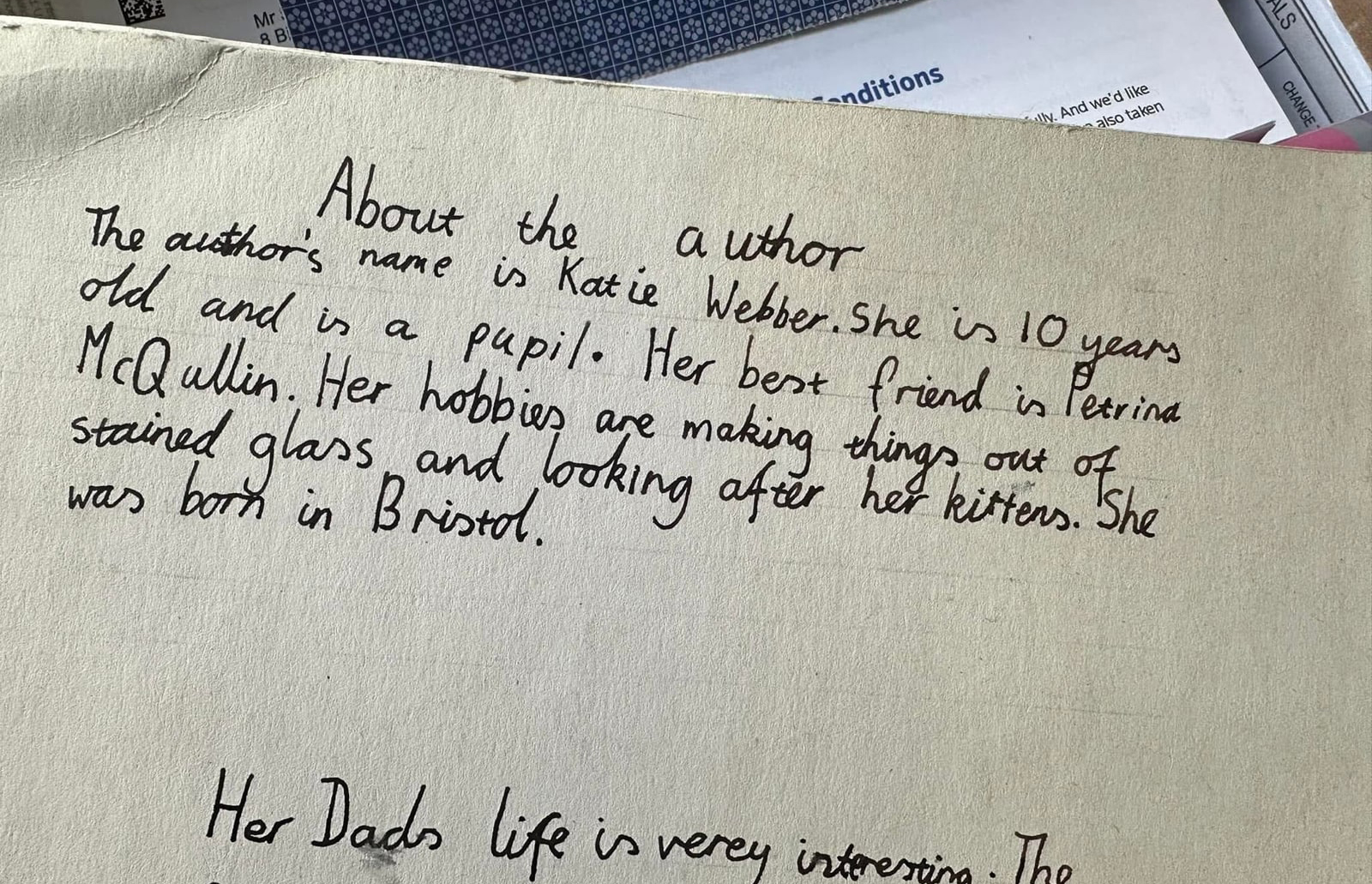
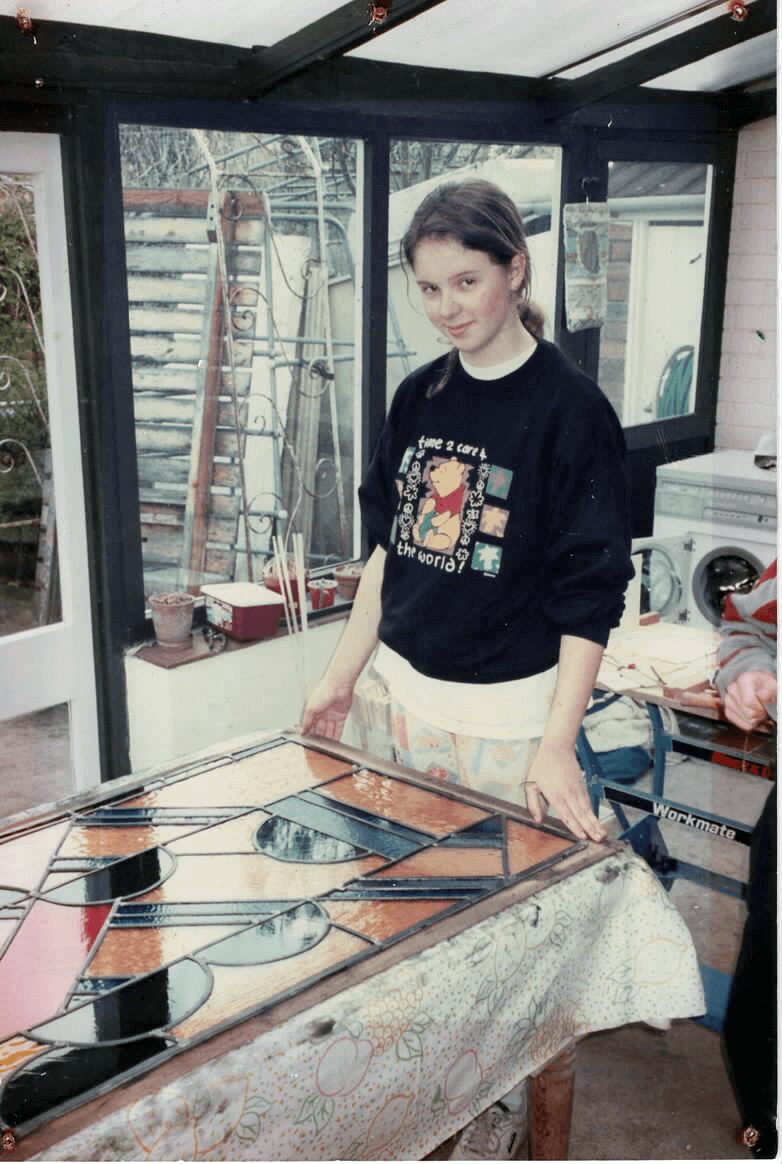
She carried on going to the workshops for six years, until she’d pretty much exhausted all they could teach her. That’s when her supportive parents set her up with a home workshop. Her dad used to patiently go with her every weekend when she went to rootle through the bin ends of glass to spend her pocket money on.
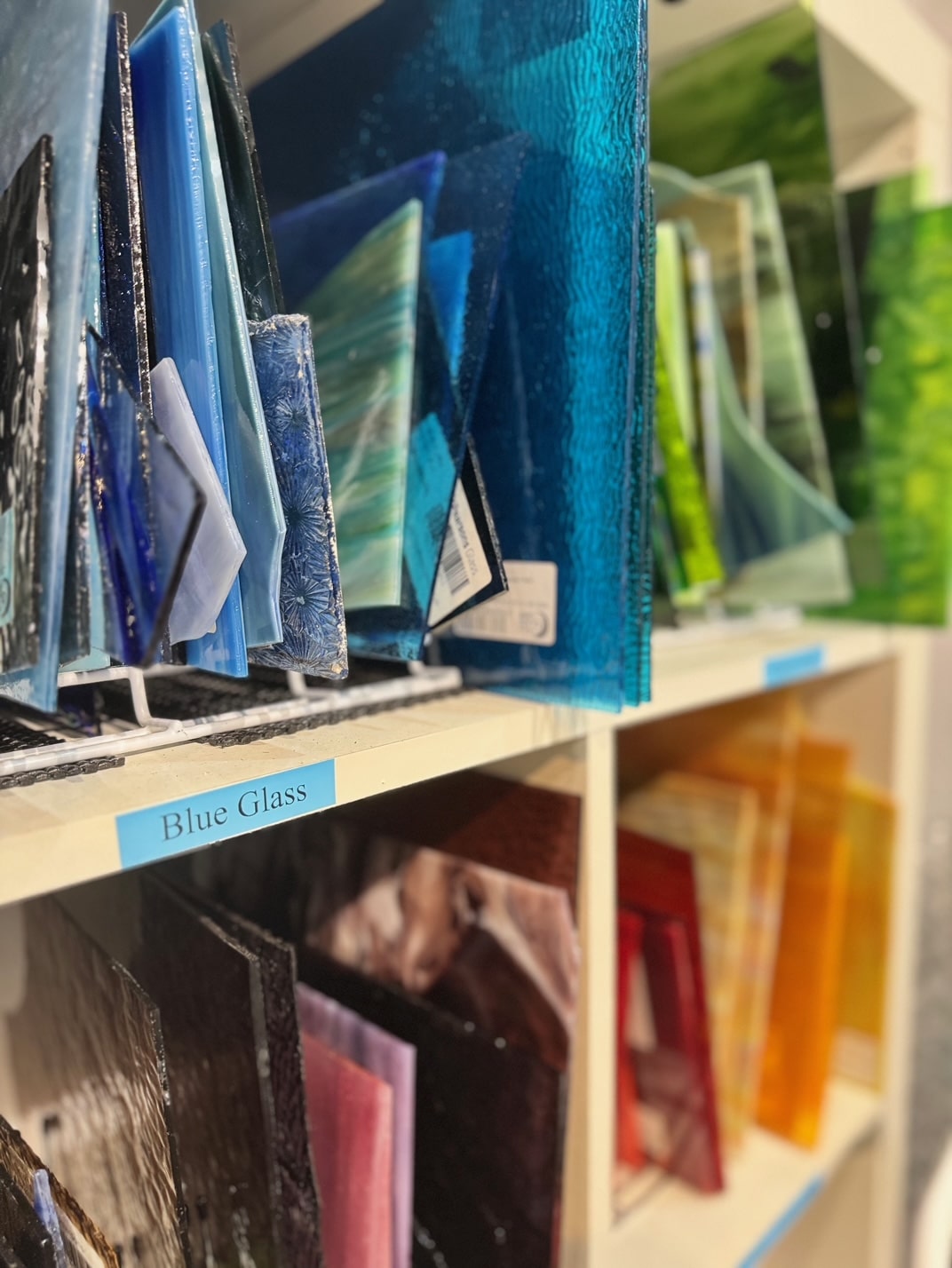
Bristol was a great place for glass–Bristol blue glass, beautiful Victorian houses with stained glass. She also remembers watching the colours from sun through stained glass windows dance on the floors of churches as a child and being enthralled with the light and patterns – but more on churches later.
She had her first commission from a neighbour for a large above door window when she was only 14. But says she made so many mistakes with the budgeting that she probably didn’t even cover her material costs, and with the fluctuating focus and concentration of a busy teenager, it felt like it took forever to complete. ‘It almost broke me!’ She lost her enthusiasm. She lost her interest when school turned her away from creative subjects when choosing her GCSE options – academically able children are often deterred from ‘wasting’ their talents on being creative. It’s silly really, why can’t we encourage children to follow their hearts? It backfired, Kate dropped out of school after attempting her A-levels but was demotivated and ended up leaving just before her final exams, had stopped doing her glass work, but did have a great time being a teenager in a big and vibrant city!
After a couple of years of ‘self exploration’ (well, getting a bit more lost), she did go back to school. She got her A levels. She went to university in Sheffield, aged 23, to study physiotherapy. She met her husband on the same course – though she specialised in neurological physio, he in musculoskeletal. They lived in Sheffield for 15 to 20 years, were happy, worked hard, had a child, worked harder, found themselves moving into managerial posts, loved their work, found their work emotionally draining (but rewarding and still loved it) – but it began to impact on Kate’s health.
They’d always loved the Lake District. They came up for holidays. Then one May when they were visiting, they discussed how if they moved here they could reduce their stress levels, concentrate more on each other, their family, their child, have fun, relax a little more. Jokingly they looked on the NHS website and found two suitable jobs in Cumbria. Then they looked at houses and found one they could afford, and liked. ‘We’re not usually spontaneous people, but we decided this on holiday in May, and we moved by September. We had a school place for our son before we even had jobs or a roof over our heads!’
The whole idea was to have a more relaxed, non-managerial lifestyle and enjoy the outdoor spaces. But they both built their new jobs into those similar to the ones they’d left behind in Sheffield.
The real impact hit along with COVID. Kate’s condition meant she had to shield so she stayed at home. She didn’t even leave the house for her daily hour of exercise. It was pretty horrible.
When she was’ freed’, it was around Mothers’ Day. She loved wild swimming and hadn’t been for ages, so they planned a special Mothers’ Day trip to Black Moss Pot. ‘A lot of people jump off the cliffs there, but I don’t usually like to risk that, I just enjoy swimming in the clear river and all the fairy pools.’ Unfortunately, the weather had been really bad and the water was churning and unsafe on the day. Kate didn’t want to risk it, the NHS and emergency services had been under so much strain, she didn’t want to risk adding to that burden. But turning to walk back to the car, she slipped on a rock, fell and dislocated her shoulder. There was no mobile signal. She was in agony. Her husband, try as he might, couldn’t get her shoulder back in. He fashioned a makeshift sling and they started the 3km walk back to the car – it took two and a half hours instead of the 45 minutes it would normally take. Such was her pain that they had to call an ambulance but the gas and air, and even morphine wouldn’t take the edge off it. By the time Carlisle hospital got her shoulder back in its socket, it had been dislocated for over 8 hours. The muscles had stretched terribly. Healing was not going to be quick. It was only at a later check-up for the shoulder that they discovered she had also ruptured all the ligaments in her ankle at the same time and a bone had been displaced, the pain from the shoulder so intense she hadn’t even noticed the ankle. There followed 9 months of reconstructive surgery on both shoulder and ankle. Then infections. Then lesions on her lungs and a benign tumour. What more could fate throw at her?
‘It was a total what the hell is going on? moment. There’s resilience and that’s a fantastic thing. But there are limits to resilience. It’s unsustainable for a long period of time. You go from being proud and praised for your resilience, to teetering on the cusp of unsustainability. I was going stir crazy at home. I was in a wheelchair. I’d read loads of books; I’d watched Netflix for hours. My husband suggested doing something creative and showed me videos on stained glass on YouTube. Then he, secretly, contacted my mum and asked if she still had my glass equipment. She couriered it up, and he set up a studio in our dining room where I could sit in my chair and work. Bam! It snowballed!’
We talk about Kate’s love of glass. She has a ‘rainbow wall’ in her studio – shelves full of glass of all colours and patterns to work with.
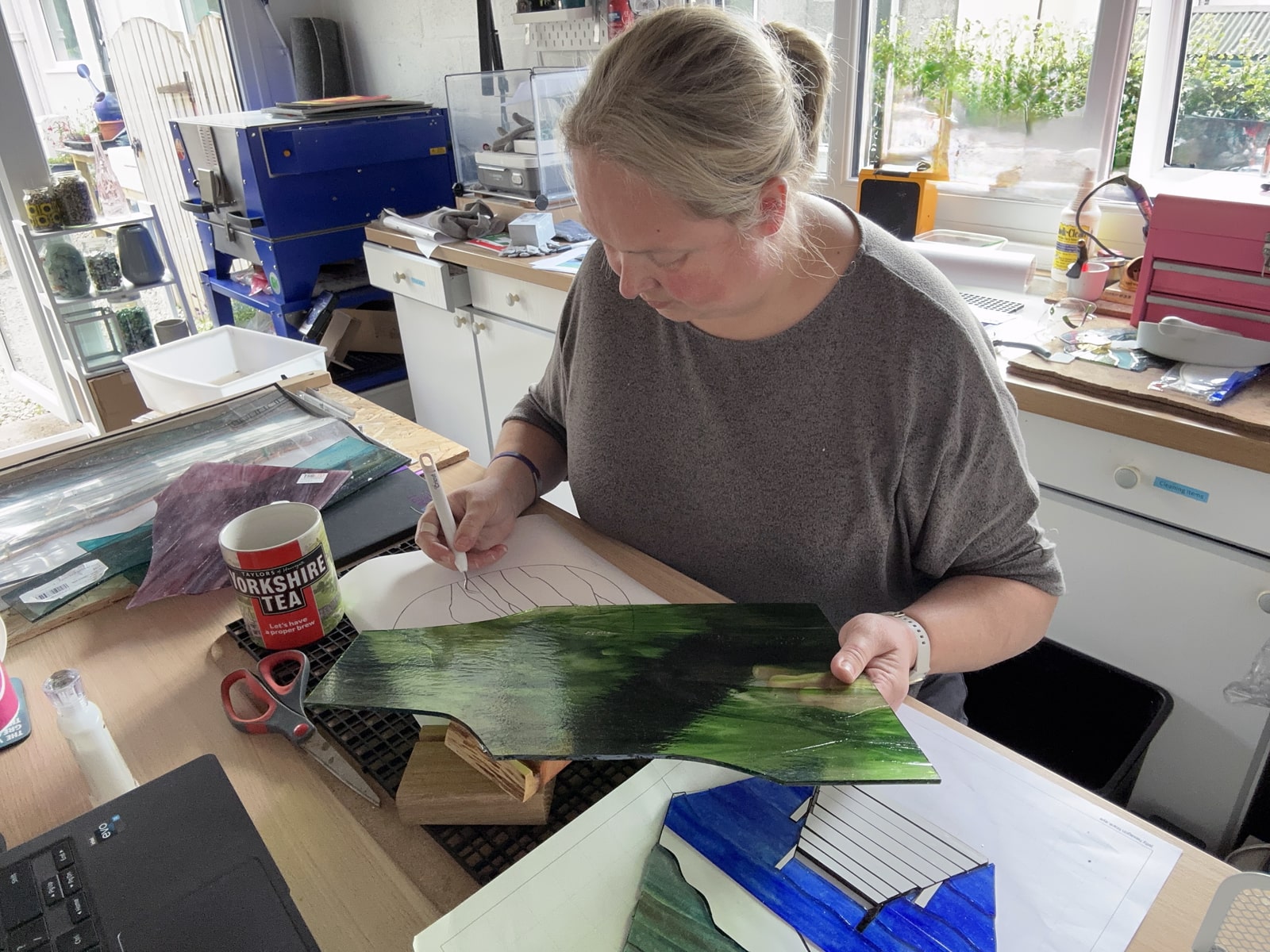
‘Glass is magical. It’s a hard medium, yet still so dynamic.’ She tells me the glass has patterns and movement within it, textures, streaks and bubbles. Even the machine-made glass nowadays can capture those same perfect ‘imperfections’ of handmade, mouth-blown glass. It’s still made in a furnace, the colours still get mixed by hand, but then it’s ‘scooped out onto a giant conveyor belt and rolled flat.’ The difference between handmade and machine made? Machine made colour mixes are less unique, less organic, more uniform, but they can be easier to cut and sometimes that uniformity can be a good thing if you want to produce multiples or for people to learn their skills on. And it’s more affordable. If she were to use only handmade mouth-blown glass it would price some people out of the market. And, like me, Kate wants people to be able to afford her work – even if it’s only a small piece.
She’s inspired by the Cumbrian landscape and nature. One look at her work and you can see this clearly.
Her workshops often reflect this. She worked with Wordsworth Grasmere running a glass flower bouquet workshop themed with Dorothy Wordsworth’s journals. ‘I read the journals and picked out flowers that Dorothy talked about. We focussed on those. There wasn’t a daffodil in sight!’
Her recent 3-D plant workshop at The Makers Mill in Keswick was great for learning. And everyone got something to take home with them which, we discuss, is exactly what you want from a workshop – something you can see, or hold, something to remind you of your learning experience, something to feel proud about, that is meaningful to you. Kate says that, strangely, those with no experience found the 3-D plants easier than those who already had experience of cutting glass – it doesn’t have to be too precise and they didn’t have any ‘rules’ they thought they should be working to.
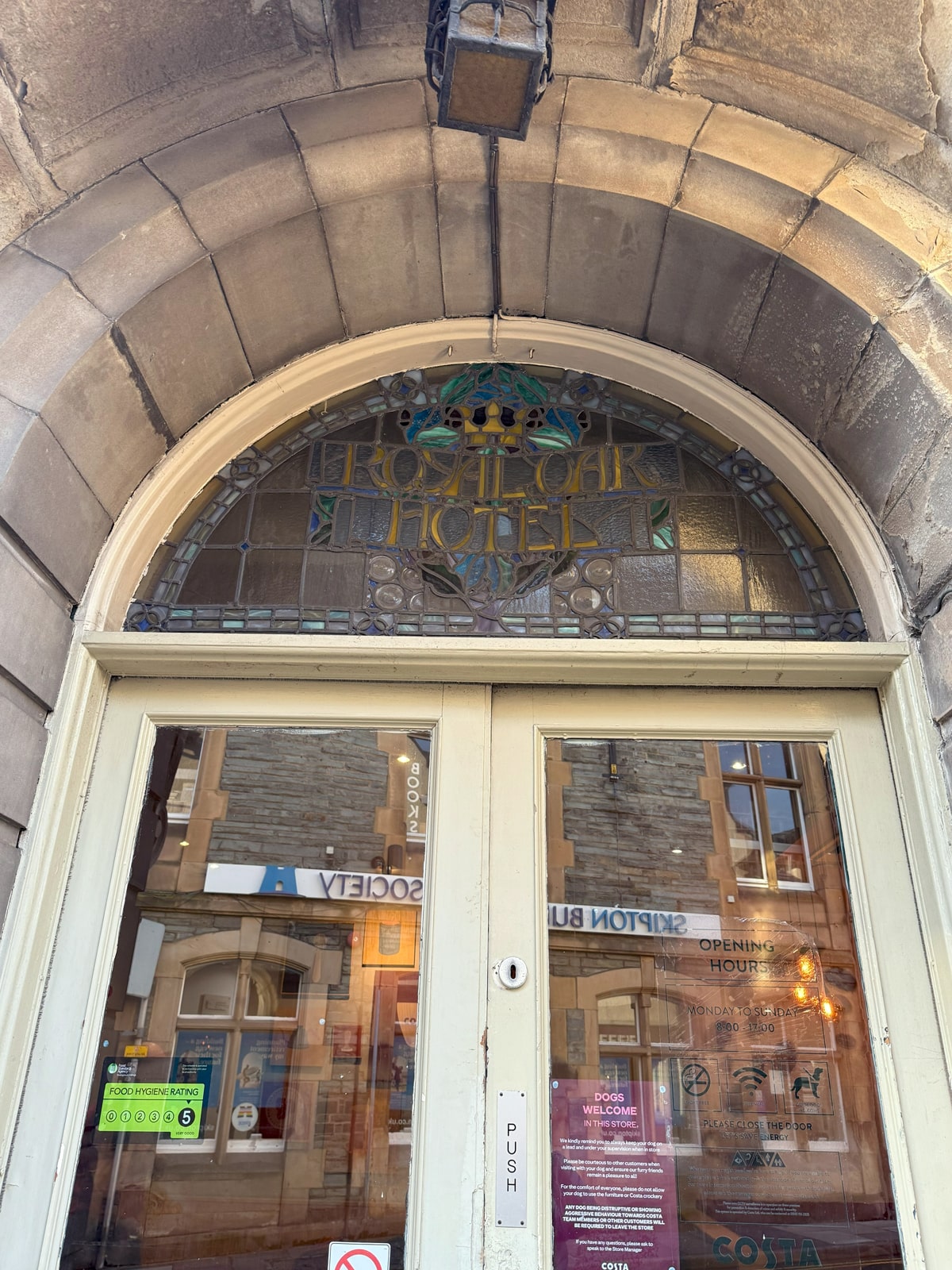
For other workshops, she provides templates for her students, and is always delighted to see the variety of results in their interpretations of the design and use of colour, each one so different from the others despite the templates being the same.
Kate hates waste. Her love of nature is linked to her care for the environment. Scraps of glass too small for her own work go into the boxes for her workshops. Scraps too small for workshops go to fellow artist Helen Clues who is a mosaic artist, or are offered to Keswick School (the school her son goes to) who run a fused glass club.
She’s constantly scrolling Facebook Marketplace looking for stained glass windows people are getting rid of. She’s got window companies, those upgrading houses for energy efficiency purposes, who will now bring her stained-glass windows they’ve removed. ‘They dump them on the drive for me!’
Though, it would be so much better if the stained glass could remain in the buildings it was designed for. It would cost more, but the more it is done the more the price would come down, but you can actually remove the original stained glass and encapsulate it within a double-glazed unit – so it actually is triple glazed, encompassing the old glass within the energy efficient new unit. She tries to speak to people about things like this, helping them understand the fine balance between what we need to function efficiently and preservation of things that, once lost, can never be replicated.
‘Stained glass tells stories. It’s in pubs or churches. In churches it tells the stories of the Saints for those who couldn’t read.’
The industry of stained glass in now listed on the Heritage Crafts Red List as an endangered craft. There are no longer enough stained-glass professionals to teach the craft and maintain Listed Building renovation. Kate’s not trained in restoration herself, though it is something she might venture into in the future. She is part of a collaboration of stained glass artists in Cumbria, a small group with a great range of techniques, all of whom are trying to sustain the craft in a both a traditional and contemporary way, as well as increasing interest in its history and heritage.
Kate started a Facebook call-out for stained glass spotting in Keswick – people telling her where it was, both in their own homes and public buildings. Costa Coffee, located in an unused section of The Royal Oak pub , has colourful stained-glass begging to be repaired hidden behind the signage but can be seen from the inside or above the doors. There’s another shop called Poet’s Interiors in Packhorse Square which sells Harry Potter products & antiques, which used to be an old Keswick banquet hall, with huge intricate stained-glass windows telling the stories of Cumbrian writers.
And that’s what Kate does – tells stories of the landscapes without words.
As well as her core lake-district inspired collections, she also works on commissions, ranging from window hangings to windows and doors, and also public art installations. Because she chooses her materials wisely, and considers her clients budgets during the design phase, her work can be affordable. She wants lots of people to be able to appreciate the splendour of glass without it breaking the bank or being only within the reach of an elite few.
What she loves about commissions is the personal memories that her clients share with her, or images of events or places with meaning to them.
Commissions are bespoke. They need two-way collaboration between maker and client. They often need an in-person visit, a connection between the maker and, in Kate’s line of work, the building or structure where the commissioned piece is to be set.
It’s a process – from sketches or photographs to thinking about where joins will be, where the forces and pressures will go. If a glass panel is above a door, you have to think about the ‘slam’ factor of people closing the door. ‘My pieces should outlast me – they’ll still be here when I’m gone.’
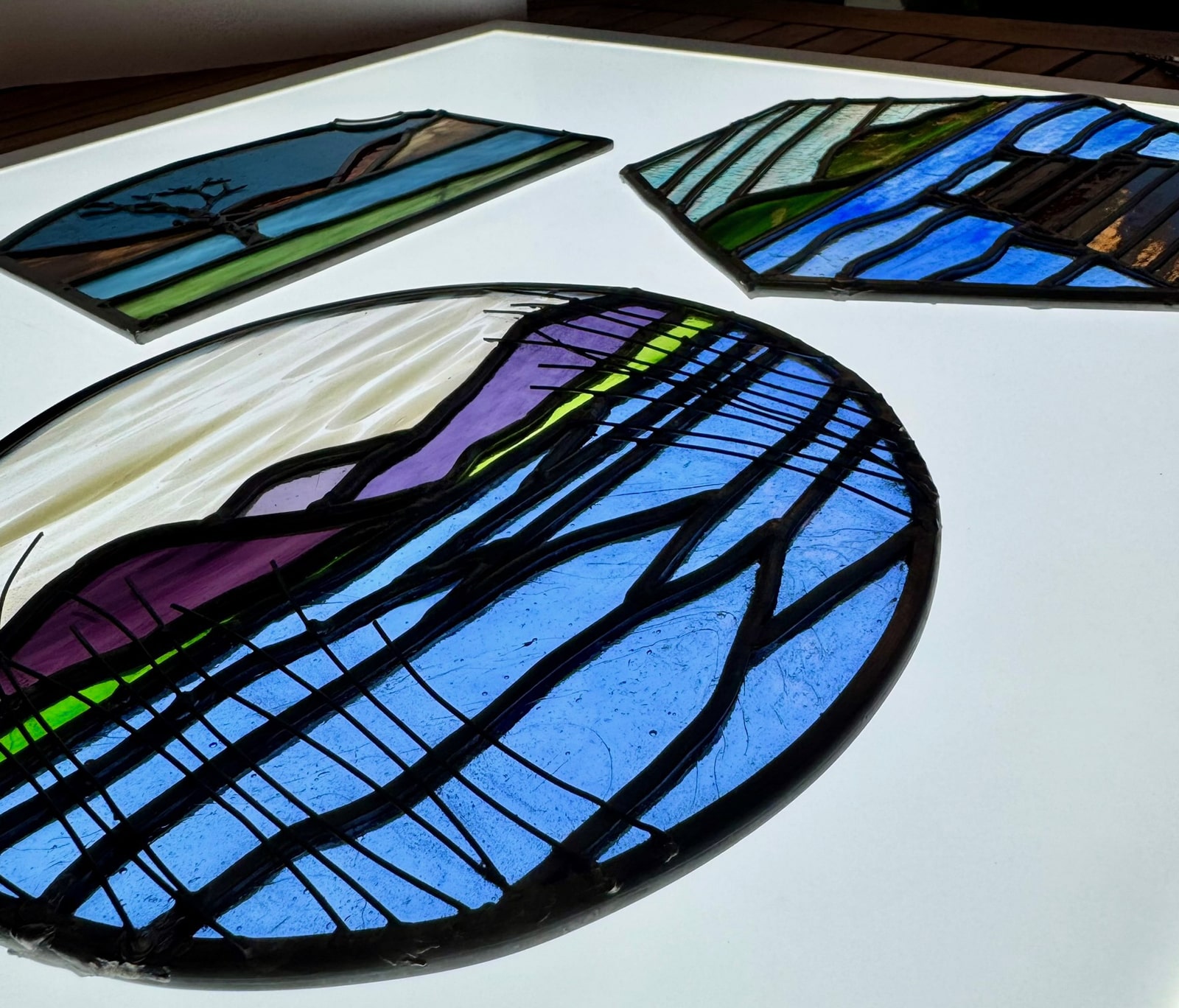
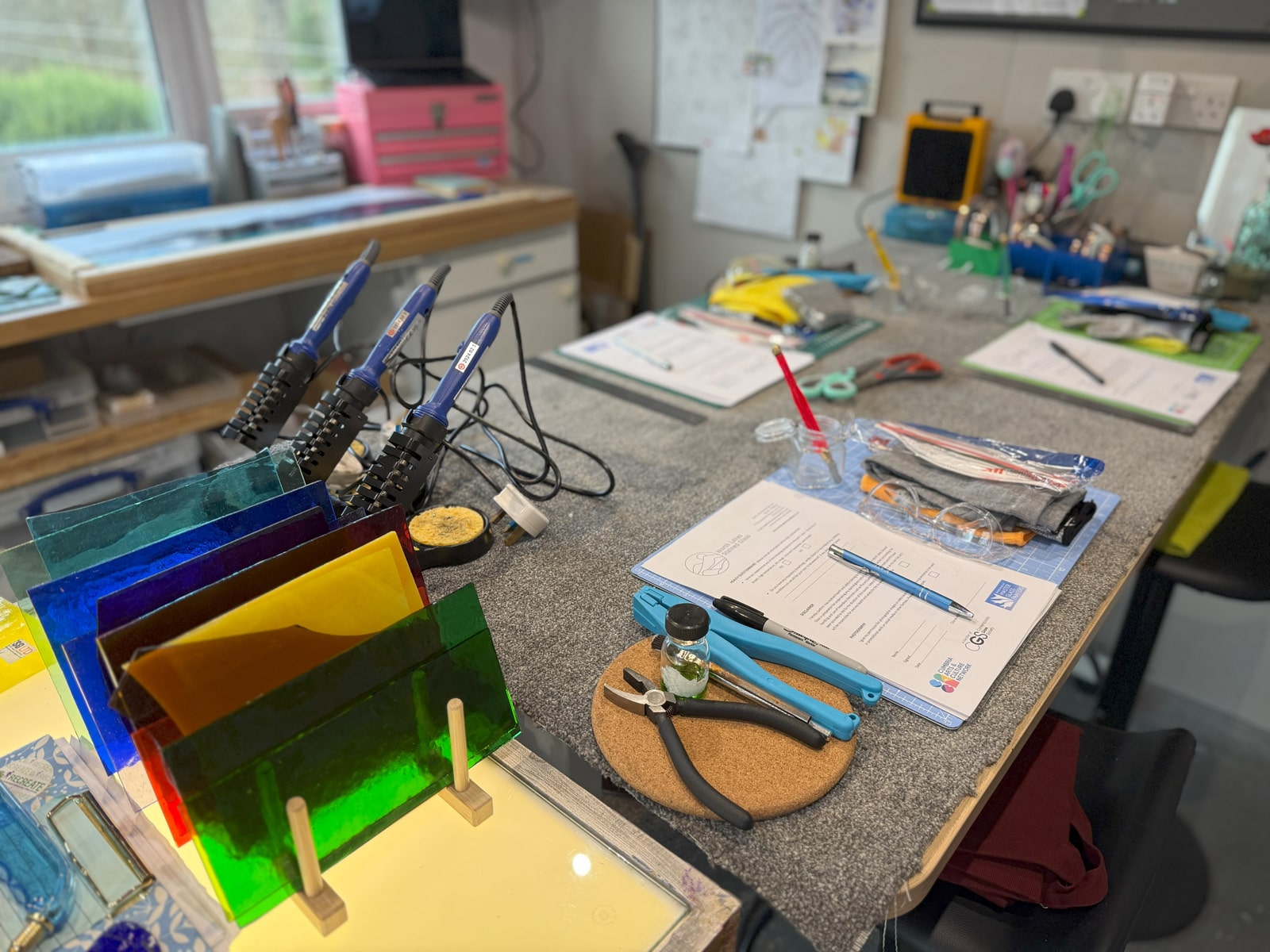
Kate’s made lots of emotional work – small hanging pieces for the wedding anniversary of a couple who brought their family up in Patterdale, and wanted to capture the views from the childhood home. One client had been unwell and wanted a piece based on the view from Catbells – the fell they aimed to climb (and conquered!) on their recovery.
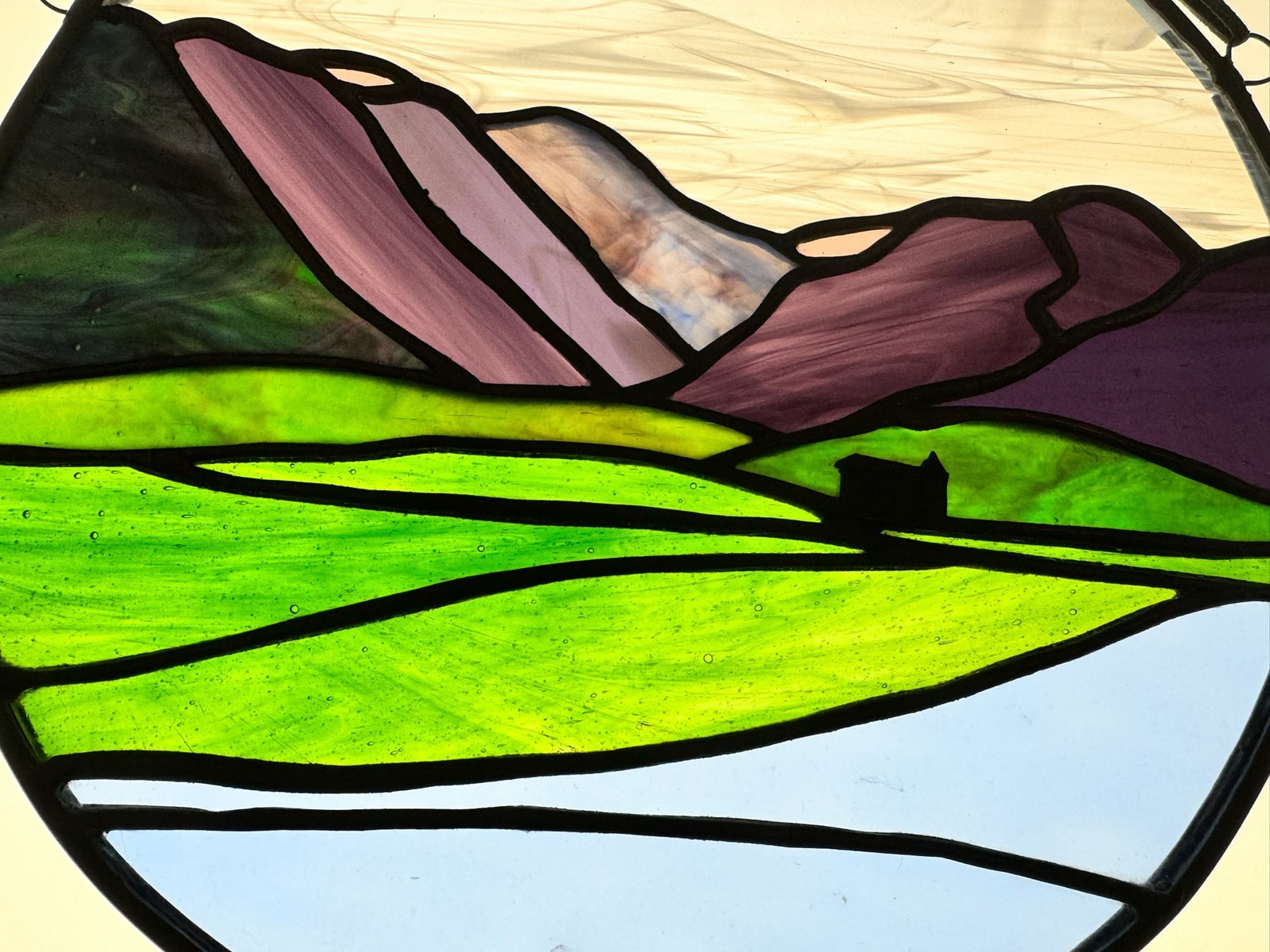
Examples of these and more can be seen on Kate’s website.
Most recently, the parents of a couple who were engaged at Ravenscragg and had a Lake District themed wedding, have commissioned a window design showing mountain vistas and capturing their memories. They sent all the photos of both engagement and wedding to Kate who is making the piece completely personal to them, their wedding, even down to featuring the wedding flowers in the glass too.
As well as wall hung or fitted-into-buildings work, Kate has found more innovative ways of displaying her pieces. Working with Boostar Wood from Leicestershire, who uses wood from a sustainable source, stands with a natural live-edge of gnarled wood allow the work to be positioned anywhere in the home rather than only in a window or can be back-lit. A local Cumbrian interior designed has enquired as to whether the pieces can be wall mounted on an LED lightbox, so they can be displayed alongside paintings and other wall art, so this is next on her ‘to-do’ list, along with exploring garden art!
‘Lone Tree by Moonlight’, inspired by a night swim at Buttermere, is one of her bestselling pieces, depicting the view from the shoreline and allowing the wood of the stand to become an extension of the glass landscape. One customer moves her piece with every season and sends Kate photos of it as it looks so different in its new position. The semi-opaque glass she utilises lets the light through, but also, even without bright light, you still get the boldness of colour.
Kate continues her recycling through to packaging her work for delivery. One food delivery company use eco packaging of wool, about 5cm thick, in their deliveries. It’s a perfect replacement for bubble wrap and beautiful enough to use in her gift boxes. Glass is so fragile, but it’s not just the glass, it’s the pressure points through the piece that need to be considered. Once again Kate turned to Facebook to see if she could set up a local network for repurposing this wool packaging and now, every month, she’ll do a road trip collecting saved wool inserts from local people.
Kate’s now left her NHS job and moved away from her Physiotherapy role to work full-time on her glass career, and is loving it.
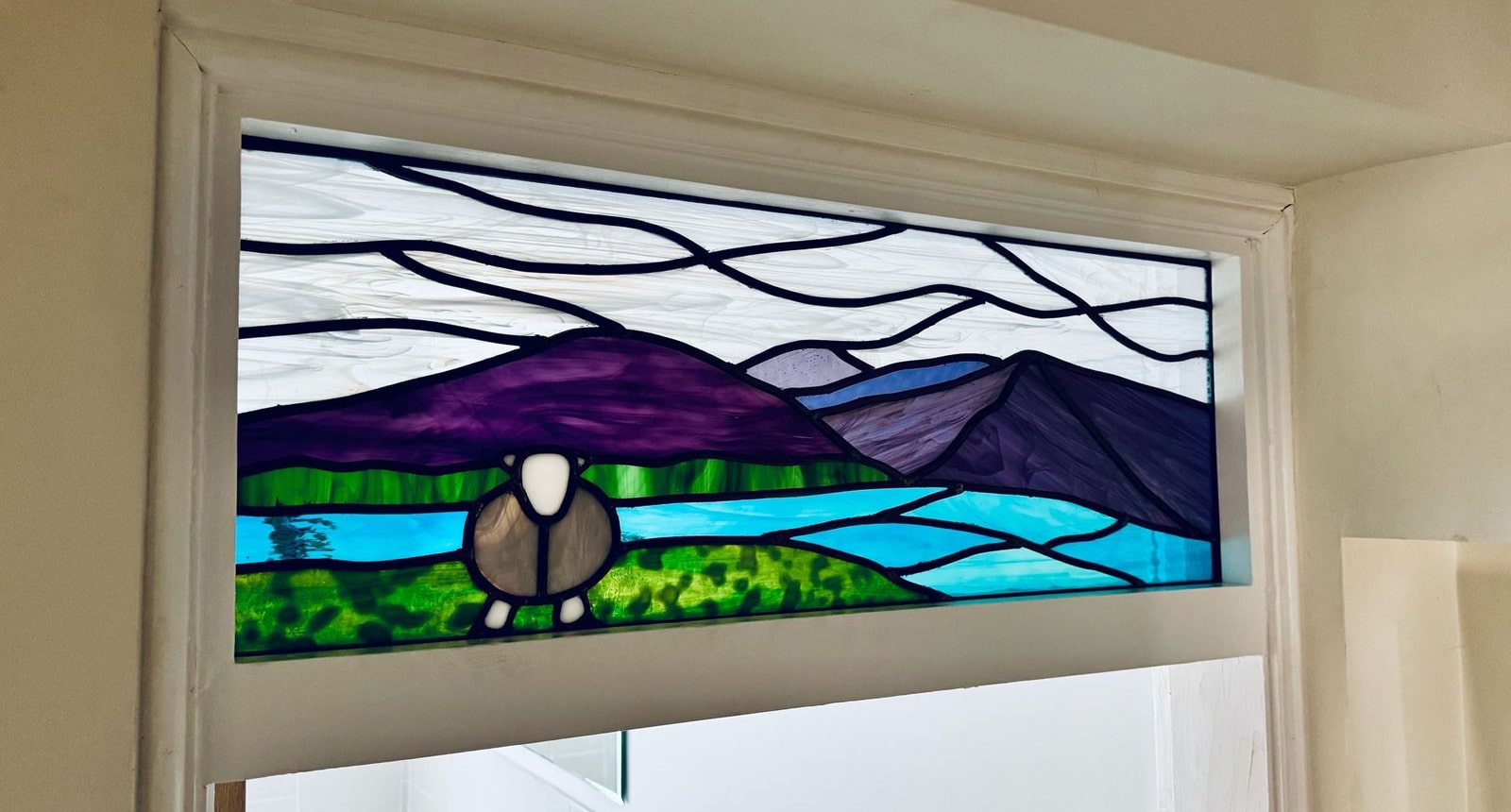
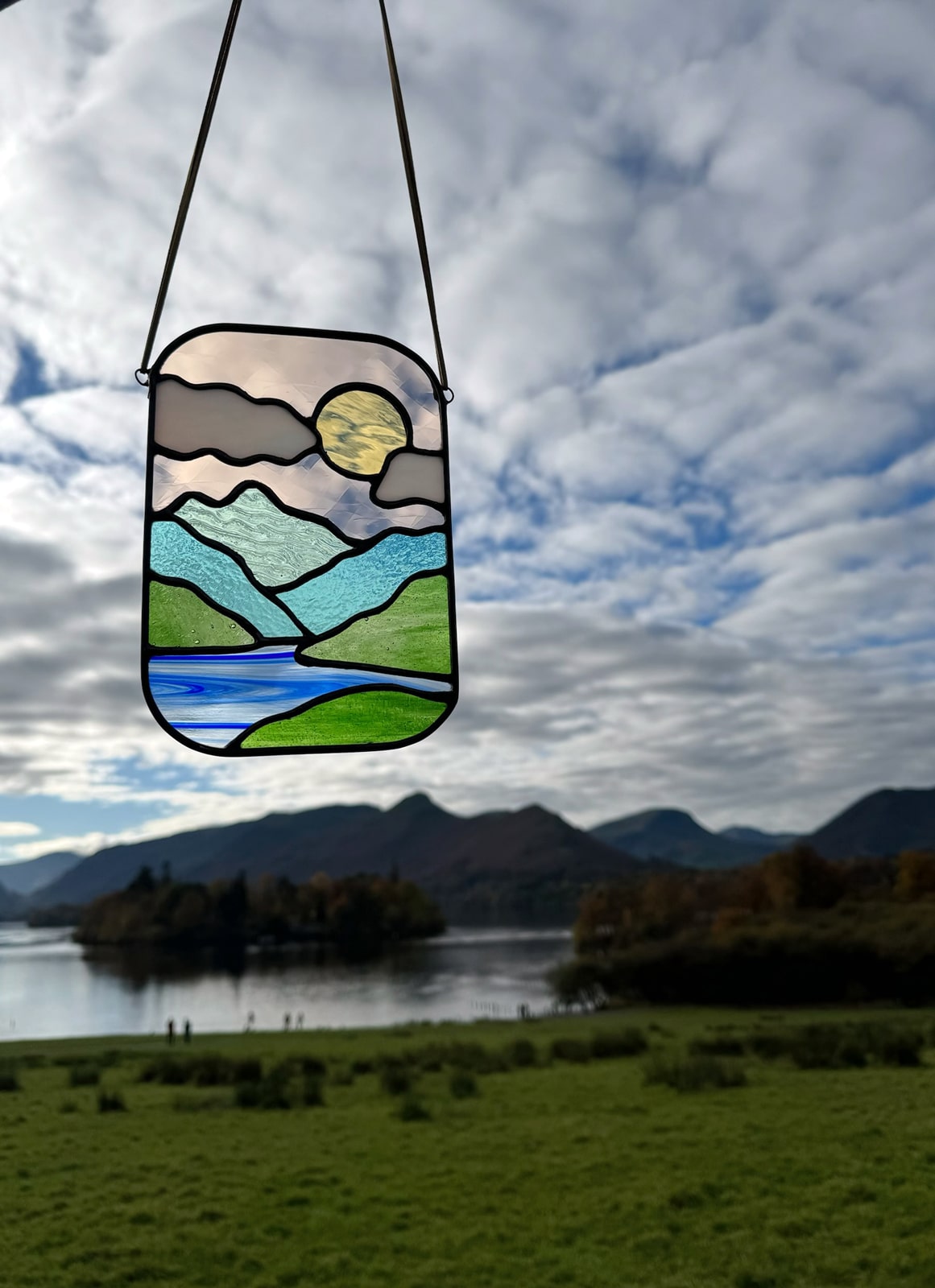
She featured on the BBC’s Make It At Market programme. It’s not something I’ve ever watched so Kate explains that it’s aimed at people who already have some expertise in their field but are uncertain about how to take it to the next level. There’s a big selection process, with the programme being shown every night of the week, featuring two makers per episode. Each maker has to produce a volume piece – something they can produce on a regular basis and from which they can make a decent profit, and then a favourite piece. They used to also make a high-end piece but this had been phased out before Kate’s series and is now a ‘mentor challenge’ related to their action plan or learning a new aspect of their craft. Kate was picked from thousands of other applicants and got through.
Each maker or artist gets a mentor. Kate was paired with Derek Hunt, a traditional but increasingly contemporary stained glass artist with an impressive social media following – Kate says she did have a little bit of a fan-girl wow moment! She got to meet him in person, visited his studio, and he was ‘so genuine and normal with no intention of shaping me into a mini version of him.’ They are now good friends and often message each other about projects or ideas for work.
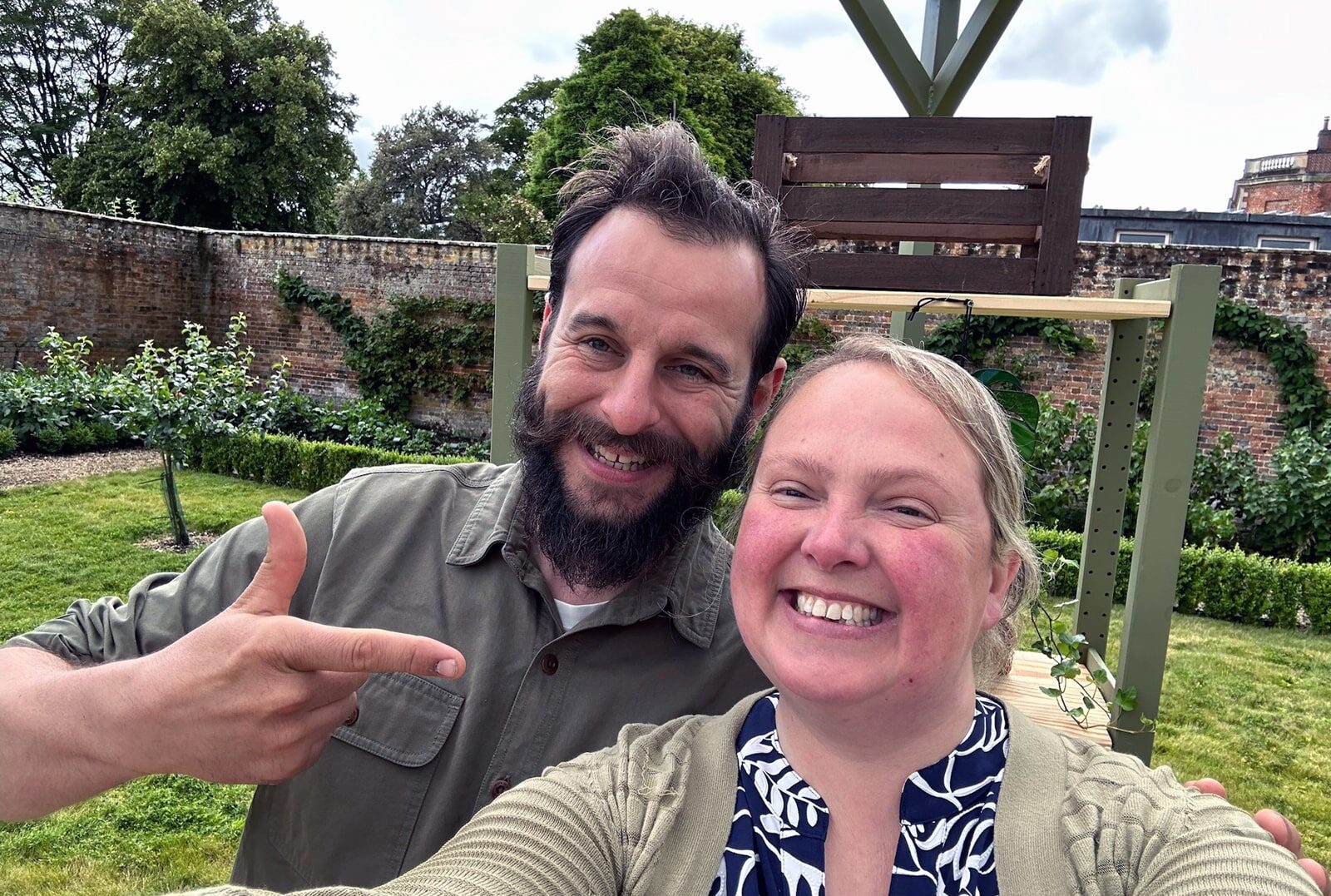
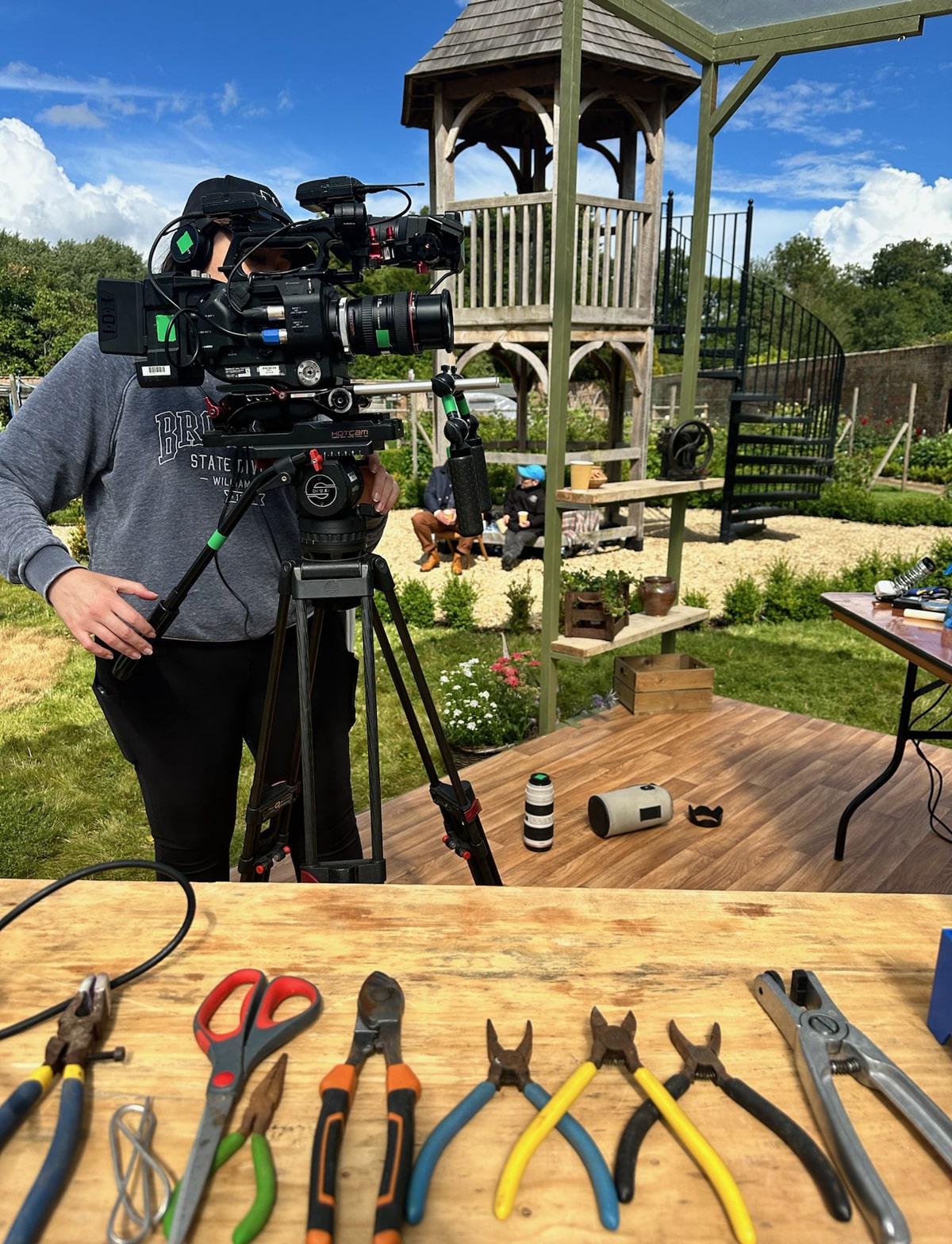
It started with some filming and an action plan. Then she had eight weeks to work on training, marketing, social media – all the things you need to know about to run a successful business. After the eight weeks she was back to filming again, explaining how things have progressed and deciding if it’s viable to go full-time.
The show was due to be aired before Christmas 2024, but was delayed until March this year. Other previous participants had reported sales going through the roof as the show went on air. And for Kate, the responses were amazing, but slow and steady rather than a clump of impulse buys which has resulted in a more sustainable business and work load. She had to put in a 12-week lead time for orders. She had to add extra classes to those she already taught, increasing from one a month to classes almost every weekend.
She handed in her notice to the NHS on New Year’s Eve 2024. For someone who says she has incredible imposter syndrome she certainly took some risks, or possibly realised she did have that potential in her after all.
She tells me it feels different now than working for the NHS, ‘I did love it, and no matter what, I knew I’d be paid at the end of the month, but it means so much more now – I’m still earning the money and contributing to my share of the family income, but now know that I did that due to the effort I put in and my decisions. I did that with my art, my passion and I feel proud again.’
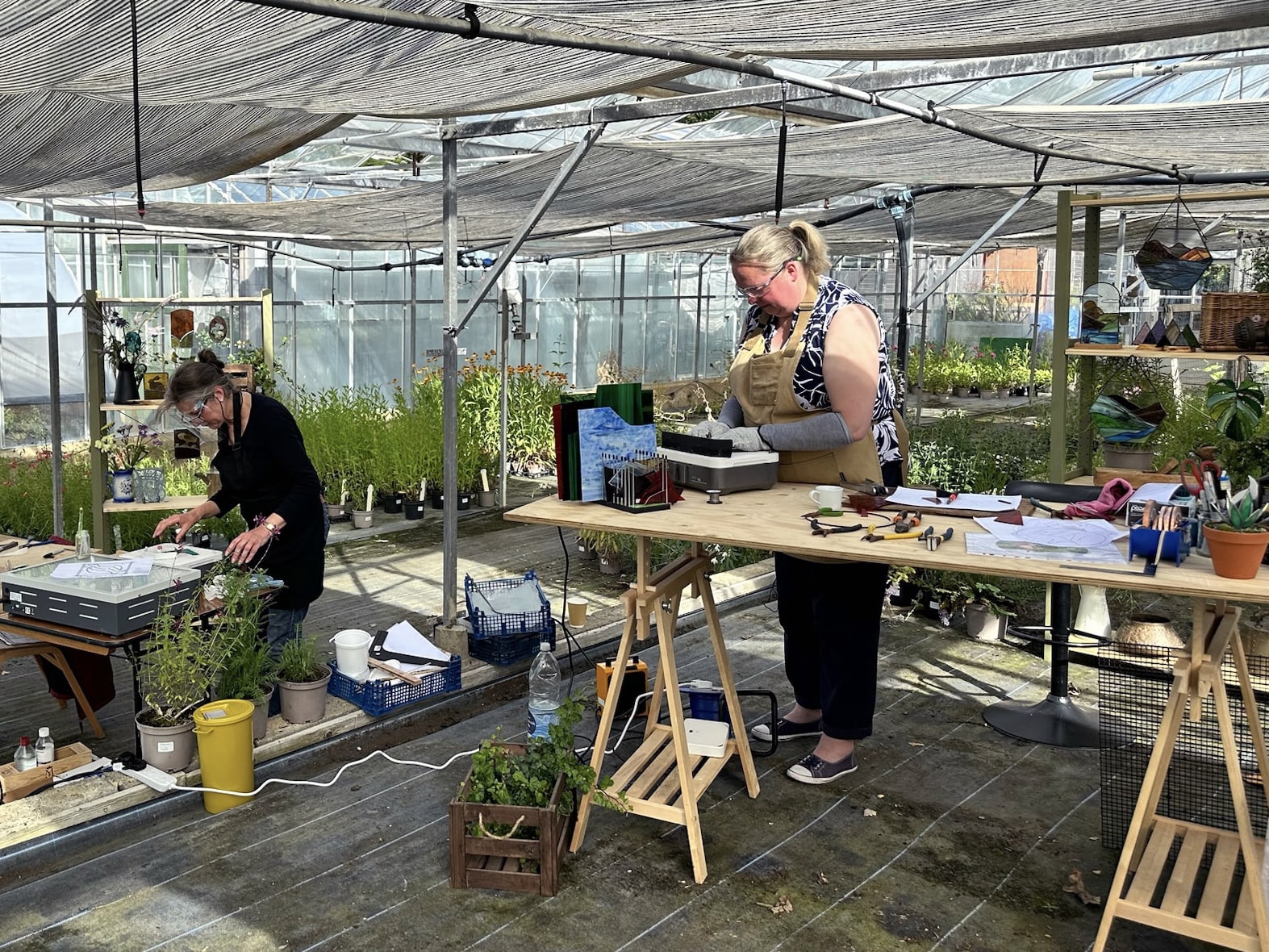
If you want to watch Kate’s episode you can find it on iPlayer, or now internationally on the BritBox platform – she’s season 3, episode 6. I know what I’ll be watching tonight.
